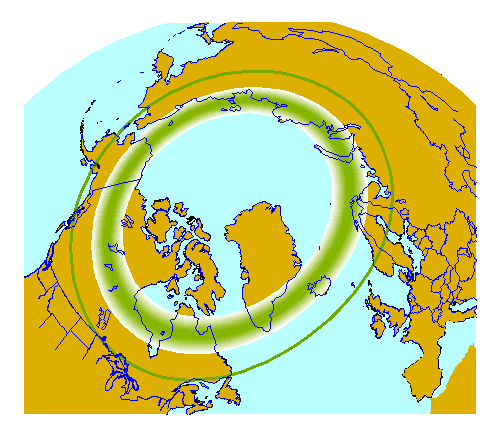

Geomagnetic storms can disrupt electronics and electrical systems and interfere with spacecraft and satellite communication. Geomagnetic storms are rated on a 1-5 scale by the SWPC, with 1 considered minor and 5 considered extreme. If the opposite happens and the Kp surges above forecast level to 7, 8, or even 9, major cities in the Mid Atlantic, across the Midwest, and throughout the Pacific Northwest could see the aurora if sky conditions cooperated.īeyond spectacular aurora, Geomagnetic Storms can also create other problems. If the Kp doesn’t reach that intensity, visible aurora could be confined to Canada.
Northern lights map free#
In past severe geomagnetic storms, the aurora has been visible as far south as Hawaii and the central Caribbean.īased on the current Geomagnetic Storm forecast from the SWPC, the aurora could be visible in clouds free of light and cloud pollution across the Great Lakes, far northern New England, the Upper Midwest, and northern portions of Montana and Washington. Should the Kp index grow higher, the aurora will drive south a Kp index of 7 or more could make the aurora present in clear skies in Boston, Chicago, and Seattle a Kp index of 9 or more could illuminate the clear night skies of Washington, DC, Saint Louis, Denver, and even Salt Lake City. The greater the number, the more vibrant aurora can be in the Northern Hemisphere, a higher Kp index also means the aurora could establish itself high above the United States in southern locations that don’t ordinarily see the Northern Lights. The current NOAA Space Weather Prediction Center (SWPC) forecast is calling for the G2 Moderate Geomagnetic Storm event to have a Kp index of 6. This illustration provides a rough guideline of where the northern lights (aurora) can appear based on the Kp index the greater that number, the more south aurora appears. Beyond signifying how bad a geomagnetic storm’s impact can be felt, the Kp index can also help indicate how low, latitude-wise the aurora will be. The SWPC says that Kp is an excellent indicator of disturbances in the Earth’s magnetic field and is used by SWPC to decide whether geomagnetic alerts and warnings need to be issued for users who are affected by these disturbances. The K-index, and by extension the Planetary K-index, are used to characterize the magnitude of geomagnetic storms.

The probability and location of aurora displays is based on the Kp index of the storm. However, a G3 storm has the potential to drive the aurora further away from its normal polar residence, and if other factors come together, the aurora might be seen over portions of Pennsylvania, Iowa, to northern Oregon.

Impacts to our technology from a G3 storm are usually minimal. When the CME approaches Earth, NOAA’s DSCOVR satellite will be among the first spacecraft to detect the real-time solar wind changes and SWPC forecasters will issue any appropriate warnings. According to the SWPC, CMEs expand in size as they propagate away from the Sun and larger ones can reach a size comprising nearly a quarter of the space between Earth and the Sun by the time it reaches our planet.Īs the CME interacts with Earth and its magnetosphere, a variety of things could unfold based on the amount of energy hitting and the angle it impacts the Earth. CMEs travel outward from the Sun at various speeds, with some reaching the Earth as quickly as 15-18 hours and others requiring days to arrive. They can eject billions of tons of coronal material and carry an embedded magnetic field, frozen in flux, that is stronger than the background solar wind interplanetary magnetic field (IMF) strength. Polarity Coronal Hole High-Speed Stream (CH HSS) influences throughout the next three days and possible Coronal Mass Ejection (CME) effects on Saturday.Ĭoronal Mass Ejections (CMEs) are large expulsions of plasma and magnetic field from the Sun’s corona. The SWPC says the moderate storm levels are likely due to the positive Image: SWPCįorecasters at NOAA’s Space Weather Forecast Center (SWPC) have issued a Geomagnetic Storm Watch for tomorrow, with a moderate, potentially disruptive event possible the strong geomagnetic storm could also produce atypical Northern Lights or aurora, with the glowing phenomena in the night sky possible as far south as Pennsylvania, Iowa, and Oregon.Īccording to the SWPC, Minor (G1) geomagnetic storm conditions are likely tonight and on Sunday, October 2 however, moderate storm levels are likely on Saturday, October 1 with G2 storm levels likely. Due to the strength of the expected geomagnetic storm, a large portion of northern North America could see the Northern Lights, or aurora, tomorrow night.


 0 kommentar(er)
0 kommentar(er)
